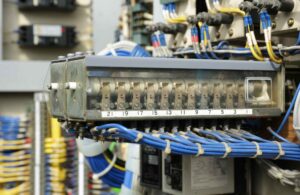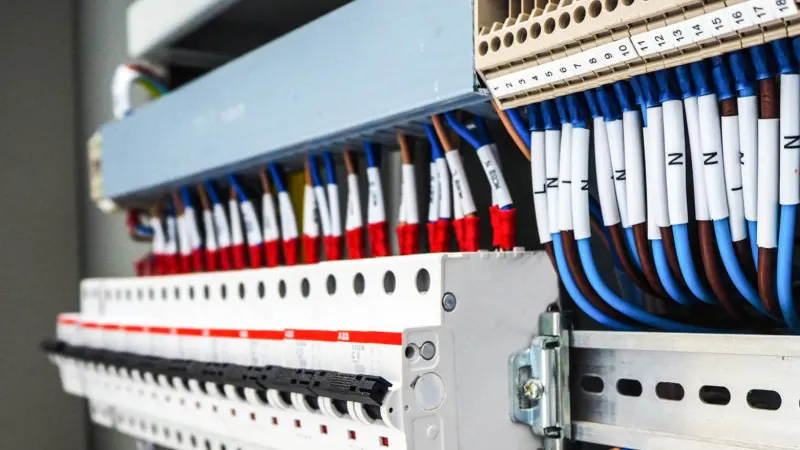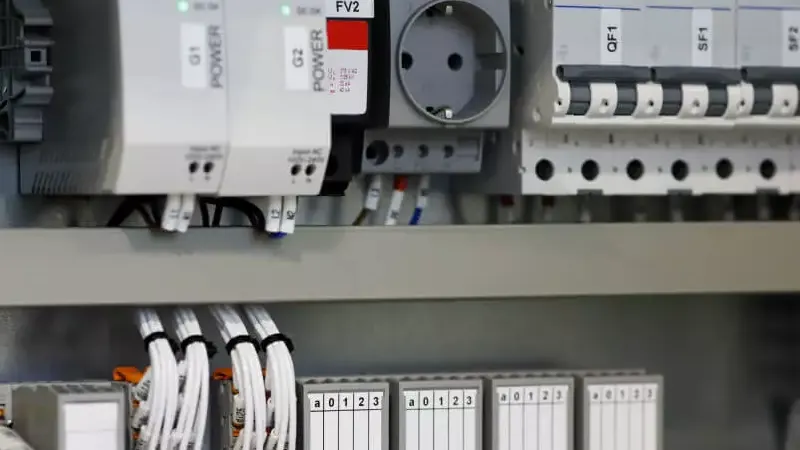Mastering PLC Panels: A Guide to Reading Wiring Diagrams
- kwoco-plc.com
- October 27, 2024
- 6:53 pm
This comprehensive guide delves into the intricacies of RTCs within PLCs, revealing how to harness their full potential in your programmes. Whether you’re setting up alarms, logging data, or synchronizing processes, understanding RTCs is essential for efficient and reliable operations.
Table of Contents
What Is an RTC (Real-Time Clock) in PLC Systems?
An RTC, or Real-Time Clock, is a timekeeping device that keeps track of the current time and date, even when the main power is disconnected. In PLC systems, the RTC ensures that time-based operations occur precisely when scheduled. It continues to run on a battery or secondary power source, maintaining accurate timekeeping during power outages.
An RTC typically consists of a crystal oscillator, which generates a precise frequency, and a battery to sustain its operation. The oscillator often operates at 32.768 kHz, allowing the RTC to count seconds, minutes, hours, and beyond. This continuous timekeeping is crucial for applications that require scheduling, data logging, or time-stamping of events.
Why Do PLCs Need a Real-Time Clock?
PLCs, or Programmable Logic Controllers, are the brains behind industrial automation. They execute programmes that control machinery and processes. But why is a real-time clock essential in PLCs?
- Time-Based Functions: RTCs enable PLCs to perform tasks at specific times, such as triggering an alarm or starting a machine.
- Data Logging: Accurate timestamps are vital when recording data for analysis, compliance, or troubleshooting.
- Synchronization: In systems with multiple devices, RTCs help synchronize operations to maintain efficiency and prevent conflicts.
Without an RTC, a PLC would lack the ability to schedule precise operations, diminishing its effectiveness in time-sensitive applications.
How to Program an RTC in a PLC
Programming an RTC involves configuring its settings and incorporating time-based instructions into your ladder logic. Here’s how you can do it:
- Access RTC Data: Retrieve the current time and date from the RTC registers.
- Use RTC Instructions: Implement instructions like
READ_RTCandSET_RTCto interact with the clock. - Incorporate into Logic: Use the RTC data in your programmes to trigger events, adjust operations, or log data.
For example, you might create a rung in your ladder logic that turns on an output when the RTC reaches a specific value, such as activating lighting at sunset.
Understanding RTC Instructions in Ladder Logic
Ladder logic is a visual programming language that represents circuit diagrams of relay logic hardware. Understanding RTC instructions in ladder logic is key to effective programming.
- READ_RTC Instruction: Reads the current time and date from the RTC and stores it in specified registers.
- SET_RTC Instruction: Sets the RTC to a new time and date value.
- COMPARE_TIME Instruction: Compares RTC data with preset values to trigger actions.
These instructions allow you to integrate the RTC seamlessly into your control logic, enabling precise timing and scheduling.
Setting Up Alarms Using the PLC's Real-Time Clock
Alarms are essential for alerting operators to specific conditions or events. Using the PLC’s real-time clock, you can set up alarms to activate at predetermined times.
Steps to Set Up an Alarm:
- Define Alarm Time: Store the desired alarm time in a register.
- Compare RTC and Alarm Time: Use a
COMPARE_TIMEinstruction to check if the RTC matches the alarm time. - Trigger Alarm Output: Activate an output device, such as a siren or light, when the comparison is true.
Remember to adjust for daylight savings time or local time changes to ensure the alarm functions correctly.
Synchronizing the PLC RTC with External Clocks
Synchronizing the RTC with an external clock ensures that your PLC’s time remains accurate, especially when coordinating with other devices.
- Connect External Device: Use communication interfaces like I2C or serial connections.
- Read External Time: Implement instructions to read time data from the external source.
- Update the RTC: Write the external time to the RTC registers.
Regular synchronization helps maintain consistency across systems, reducing errors due to time discrepancies.
Troubleshooting Common RTC Issues in PLCs
Even with reliable hardware, RTCs can encounter issues. Here’s how to address common problems:
- Battery Failure: A depleted battery can cause the RTC to reset. Replace the battery or secondary power source to maintain operation.
- Oscillator Malfunction: If the crystal oscillator fails, the RTC won’t keep accurate time. Check the oscillator circuit and replace faulty components.
- Software Errors: Incorrect programming can lead to RTC issues. Review your ladder logic and instructions to ensure they’re correct.
- Environmental Factors: Extreme temperatures or electromagnetic interference can affect the RTC. Protect your PLC with proper shielding.
RTC Modules vs. Built-In RTCs: Which Is Better?
When it comes to RTCs in PLCs, you have two options:
Built-In RTCs
- Advantages: Integrated into the PLC, no extra hardware required, lower power consumption.
- Disadvantages: May have limited features or less precision.
RTC Modules
- Advantages: Offer advanced features, higher accuracy, and can be added to PLCs without built-in RTCs.
- Disadvantages: Require additional programming and increase system complexity.
Decision Factors:
- Application Needs: Consider precision and features required.
- Cost: Modules add expense.
- Complexity: Built-in RTCs are simpler to implement.
Power your projects with brand-new, original Omron, Mitsubishi, Schneider PLC – in stock, ready now!
Real-Time Clock Applications in Industrial Automation
RTCs are used in various applications:
- Data Logging: Accurate time stamps for recorded data.
- Scheduled Operations: Automate tasks like equipment startup or shutdown.
- Energy Savings: Control systems based on time to reduce power consumption.
- Alarm Systems: Trigger alarms at specific times or intervals.
By leveraging RTCs, you enhance the functionality and efficiency of your automation systems.
How to Update and Maintain the RTC in Your PLC
Regular maintenance ensures your RTC functions properly:
- Replace the Battery: Swap out the battery when it’s low to prevent time loss.
- Synchronize Regularly: Sync the RTC with an accurate external clock to correct drift.
- Firmware Updates: Keep your PLC’s software up to date to benefit from improvements and fixes.
- Monitor Performance: Use diagnostic tools to check the RTC’s status and address issues promptly.
FAQs
How do I change the date and time on my PLC's RTC?
Access the RTC settings through your PLC's programming software. Use the SET_RTC instruction to input the new date and time values. Refer to your PLC's manual for specific steps..
What happens if the RTC battery fails?
If the battery fails, the RTC may reset when power is lost, causing incorrect timekeeping. Replace the battery promptly to maintain accurate time.
Can I synchronize multiple PLCs using the RTC?
Yes, you can synchronize multiple PLCs by connecting them to a common external clock or network time protocol. This ensures all devices operate with the same time reference.
Do PLCs automatically adjust for daylight savings time?
Some PLCs have built-in functions to adjust for daylight savings time automatically. If not, you'll need to program this adjustment manually in your ladder logic.
Why is my RTC losing time accuracy?
Time loss can be due to a failing crystal oscillator or environmental factors affecting the oscillator's frequency. Check the oscillator and consider synchronizing the RTC more frequently.
Conclusion
- RTCs Enable Time-Based Control: Essential for scheduling, data logging, and synchronized operations in PLCs.
- Proper Programming Is Crucial: Use RTC instructions effectively in your ladder logic for precise control.
- Maintenance Prevents Issues: Regular battery replacement and synchronization keep the RTC accurate.
- Choose the Right RTC Type: Decide between built-in RTCs and modules based on your application’s needs.
- Stay Proactive: Monitor and troubleshoot RTC issues to ensure reliable system performance.
By mastering real-time clocks in PLC programming, you unlock new possibilities for automation, efficiency, and precision in your operations.
Looking for new, original PLCs for your projects? At Kwoco, we stock the latest PLCs from top brands like Omron, Mitsubishi, and Schneider. Shop with confidence—fast shipping, guaranteed quality! Buy Now
Contact Us
Just fill out your name, email address, and a brief description of your inquiry in this form. We will contact you within 24 hours.
You May Also Find These Topics Interesting

Understanding Analog Inputs in PLC Systems: Bridging the Gap Between Digital and Analog Signals
Analog inputs are the lifeline of modern automation systems, acting as the crucial link between physical processes and digital controllers like PLCs (Programmable Logic Controllers). Grasping the concept of analog inputs and how they differ from digital inputs is essential for anyone involved in industrial automation. This article will delve into what analog inputs are, how they function within PLC systems, and why understanding the differences between analog and digital signals is vital.

Understanding Mitsubishi PLC Programming: Languages and Tools
In the fast-evolving world of industrial automation, selecting the right PLC programming language is crucial. Many engineers and technicians grapple with understanding which languages best suit Mitsubishi PLCs and how to effectively utilize them for optimal performance.

Demystifying Magnetic Switches: A Comprehensive Guide for Industrial Applications
This article provides an in-depth look at magnetic switches, exploring their function, benefits, and applications, particularly within industrial settings. Whether you’re a seasoned engineer or new to the world of industrial automation, this guide will equip you with a thorough understanding of how magnetic switches can enhance your operations. We aim to demystify these devices and showcase why they are a critical component in modern manufacturing and automation systems.






